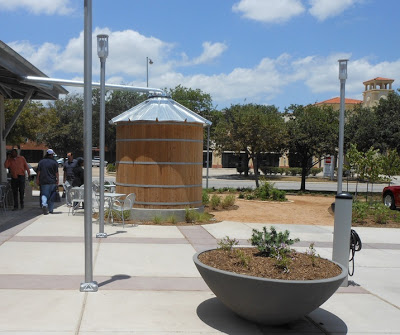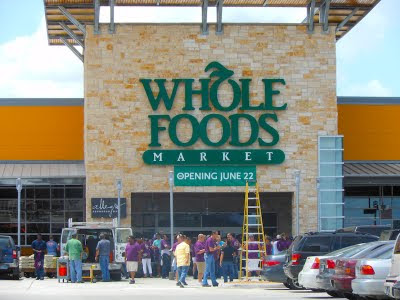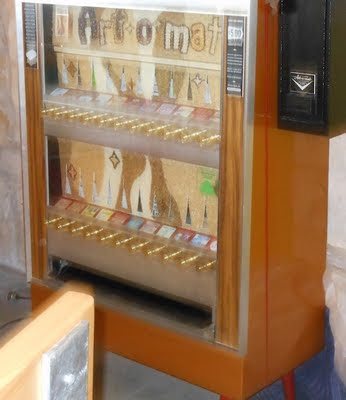Whole Foods - Walking the Walk
June 22, 2011
by Chuck Pena
Houston is doing pretty well in what we all seem to be
calling "this economy." However, even the best-run luxury lifestyle
establishments, particularly those in fitness, food, and furniture, have
suffered recent reductions-in-force or closures, even in the upscale Galleria
and in the trendy, aggressively marketed and re-gentrified Houston Heights.
calling "this economy." However, even the best-run luxury lifestyle
establishments, particularly those in fitness, food, and furniture, have
suffered recent reductions-in-force or closures, even in the upscale Galleria
and in the trendy, aggressively marketed and re-gentrified Houston Heights.
Given that status quo, one might question the wisdom of
Whole Foods opening their brand of a high-end, self-described "ultimate"
shopping experience, located between Montrose and the Heights at this particular time. The land in Houston
hasn't really suffered, so it can't be an opportunity that they can't refuse on
the lot.
Whole Foods opening their brand of a high-end, self-described "ultimate"
shopping experience, located between Montrose and the Heights at this particular time. The land in Houston
hasn't really suffered, so it can't be an opportunity that they can't refuse on
the lot.
Also, Houston and surrounding areas already offer three Whole Foods, Central Market,
Hubble and Hudson, a handful of Rice
Epicureans, and HEB's latest crown jewel, Buffalo Market. All of these
groceries/restaurants play in the epicurean/green/organic market space.
Hubble and Hudson, a handful of Rice
Epicureans, and HEB's latest crown jewel, Buffalo Market. All of these
groceries/restaurants play in the epicurean/green/organic market space.
I arrived at the preview tour truly curious about why they
were here, and why right now. Years ago, I'd been a customer of Whole Foods in
Austin, both at the North Lamar location and at Westgate, and found them to be
largely venues for a slacker/yuppie mix of posers with attitudes about what
makes a good kiwi or pomegranate. I
guess that no matter how right I was at that time, what I neglected to register
that they did, indeed, have kiwis and pomegranates, fresh ones.
were here, and why right now. Years ago, I'd been a customer of Whole Foods in
Austin, both at the North Lamar location and at Westgate, and found them to be
largely venues for a slacker/yuppie mix of posers with attitudes about what
makes a good kiwi or pomegranate. I
guess that no matter how right I was at that time, what I neglected to register
that they did, indeed, have kiwis and pomegranates, fresh ones.
As a Texan, I'm obliged to be man enough to reconsider my
opinions given new data, and surely enough, as the tour progressed, I had no
choice but to readjust those old stereotypes of Whole Foods. This place, or at
least our great town's latest incarnation of it, is a lot more than a
"luxury shopping experience"—that is, a place that simply stocks the
better or rarer items. Whole Foods represents a comprehensive commitment to genuinely
implement "green" in every aspect of their business.
opinions given new data, and surely enough, as the tour progressed, I had no
choice but to readjust those old stereotypes of Whole Foods. This place, or at
least our great town's latest incarnation of it, is a lot more than a
"luxury shopping experience"—that is, a place that simply stocks the
better or rarer items. Whole Foods represents a comprehensive commitment to genuinely
implement "green" in every aspect of their business.
The green commitment includes not only the meat and produce,
but every packaged item, every bulk item, every fresh-made item, every prep
facility, and every sourcing practice. It also includes the architecture of the
building and even the physical plant, right down to the water reclamation
subsystem that provides the water for drinking, washing, cooling (even the meat
lockers) and landscaping.
but every packaged item, every bulk item, every fresh-made item, every prep
facility, and every sourcing practice. It also includes the architecture of the
building and even the physical plant, right down to the water reclamation
subsystem that provides the water for drinking, washing, cooling (even the meat
lockers) and landscaping.
 |
| Water reclamation system at Whole Foods |
Local growers are
used whenever available, and items are offered strictly when they are
available, on a seasonal basis. Local sourcing and seasonal offering
significantly reduces the business' carbon footprint in trucking transit and
long-term storage.
used whenever available, and items are offered strictly when they are
available, on a seasonal basis. Local sourcing and seasonal offering
significantly reduces the business' carbon footprint in trucking transit and
long-term storage.
Of course, the name Whole Foods pervades the merchandizing
philosophy. This is the only place I know of that I could buy anything from a
box of cookies to a fresh-made deli sandwich from one of the many fresh-food
counters and not have to worry about consuming one gram of color additives, trans-fatty
acids, artificial sweetener, endangered animal, unsustainably-farmed grain,
stripped grain, or bleached grain.
philosophy. This is the only place I know of that I could buy anything from a
box of cookies to a fresh-made deli sandwich from one of the many fresh-food
counters and not have to worry about consuming one gram of color additives, trans-fatty
acids, artificial sweetener, endangered animal, unsustainably-farmed grain,
stripped grain, or bleached grain.
What makes it better, all this tasty-yet-guilt-free bounty is
offered in a beautiful, bright,
comfortable facility with an near-zero carbon footprint. Downside: no
double-stuff Oreos...
offered in a beautiful, bright,
comfortable facility with an near-zero carbon footprint. Downside: no
double-stuff Oreos...
That's when you realize that this is not a business playing in the luxury grocery space at all, but indeed have invented their own product: they're not selling you truffled spinach pesto from Sicily; they're selling you a sustainable lifestyle—or at least as much of the part of one as they can that relates to food.
So I recommend that your first stop be the coffee stand.
Similar in size to a Starbucks in other grocers, this is a separate business,
similar to how Panera bread shares space with Schlotzky's in Austin. The
Starbuck's-killing features here are the local roaster, and the availability of
some of the rarest coffees in the world. Now, these top-shelf brews are not
cheap, but they are appropriate and creative 21st-centruy alternatives to
bringing a bottle of wine to every holiday. Be forewarned however; the
"Dom Perignon" of coffees can run you $75/lb of roasted beans.
Similar in size to a Starbucks in other grocers, this is a separate business,
similar to how Panera bread shares space with Schlotzky's in Austin. The
Starbuck's-killing features here are the local roaster, and the availability of
some of the rarest coffees in the world. Now, these top-shelf brews are not
cheap, but they are appropriate and creative 21st-centruy alternatives to
bringing a bottle of wine to every holiday. Be forewarned however; the
"Dom Perignon" of coffees can run you $75/lb of roasted beans.
Beyond the coffee stand is the front porch, which blends in
with the coffee shop seating. Both areas are equipped with wi-fi and feature
works by local artists. I didn't get any good shots of the art, sorry. One of
the more interesting interactive pieces is the "art vending" machine:
a converted 1960s cigarette machine that
makes original art placards, suitable for a coaster, for $5 apiece. It's all
similarly-appealing, non-threatening -but-still-occasionally-provoking, urban
fare.
with the coffee shop seating. Both areas are equipped with wi-fi and feature
works by local artists. I didn't get any good shots of the art, sorry. One of
the more interesting interactive pieces is the "art vending" machine:
a converted 1960s cigarette machine that
makes original art placards, suitable for a coaster, for $5 apiece. It's all
similarly-appealing, non-threatening -but-still-occasionally-provoking, urban
fare.
Which, by the way, is a great description of the
freshly-prepared food area; I'm loathe to call it a "food court"
simply because of the images that that phrase recalls to me. The Whole Foods
version as the deli, Italian, pizzas, bistro, olive bar, extreme dry-rub
barbecue with ready-to-go, all-organic briskets, and then the perfunctory salad
bar and premade cold fare. This area is so huge you might even be able to
navigate your cart through on a Sunday, which believe me, is going to be
pa-aaaa-aaaked.
freshly-prepared food area; I'm loathe to call it a "food court"
simply because of the images that that phrase recalls to me. The Whole Foods
version as the deli, Italian, pizzas, bistro, olive bar, extreme dry-rub
barbecue with ready-to-go, all-organic briskets, and then the perfunctory salad
bar and premade cold fare. This area is so huge you might even be able to
navigate your cart through on a Sunday, which believe me, is going to be
pa-aaaa-aaaked.
We've covered a lot, but several major points of interest
remain:
remain:
Peanut butter grinding. This is a station where you can grind and jar
your own peanut, almond, or cashew butter.
Bulk area includes barbecue rubs and seasonings,
including a tethering system that discourages "scooper-sharing" from
container-to-container, a big pet-peeve of mine.
Wine bar, conveniently located right by the
cheese counter, that opens at 8am, which, oh, BTW, offers 24 beer taps. I'm
thinkin', if you take advantage of this amenity, you may want to bring a designated
driver AND shopper.
Finally, I must mention the attitude of the Whole Foods team
associates. Any specialist in any area is always happy to tell you about how
they achieve their quality and how they're doing things differently, and their
sense of ownership and pride is obvious. This point perhaps illustrates the
difference in the Whole Foods experience that I realized that day: Everyone,
every facility, every practice, spoke with one voice, one message—and that is
the hallmark of the most successful ventures in the world.
associates. Any specialist in any area is always happy to tell you about how
they achieve their quality and how they're doing things differently, and their
sense of ownership and pride is obvious. This point perhaps illustrates the
difference in the Whole Foods experience that I realized that day: Everyone,
every facility, every practice, spoke with one voice, one message—and that is
the hallmark of the most successful ventures in the world.
Of course, this store shall attract its share of tiresome,
iPad-addicted, Croc-clad hipster clones, but if you're someone who takes your
green commitment beyond the purchase of a Prius, beyond whining on political
blogs, into actual practices in your life, then this is your store. You are why
Whole Foods is expanding; you are the niche I didn't see before.
iPad-addicted, Croc-clad hipster clones, but if you're someone who takes your
green commitment beyond the purchase of a Prius, beyond whining on political
blogs, into actual practices in your life, then this is your store. You are why
Whole Foods is expanding; you are the niche I didn't see before.
I thought we may have had too many Whole Foods, but now,
maybe we don't have enough. They're not a player in the luxury grocery space at
all: their product is a slice of a relevant, green lifestyle, from the food
itself (no additives, organic) to how they get it there (local, seasonal
growers) to how they offer it (green outlet architecture and engineering).
maybe we don't have enough. They're not a player in the luxury grocery space at
all: their product is a slice of a relevant, green lifestyle, from the food
itself (no additives, organic) to how they get it there (local, seasonal
growers) to how they offer it (green outlet architecture and engineering).
Get this as well—if you do drive a Nissan Leaf or other electric vehicle, you can charge it up right outside by the rainwater reclamation tank.
I gotta say, it's truly impressive to see a corporation that
doesn't just talk the talk.
doesn't just talk the talk.
Best of luck, Whole Foods. Welcome to the neighborhood.


